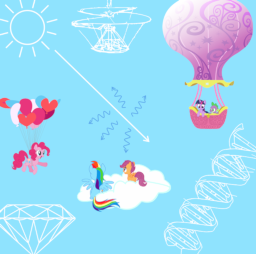
The Dark Side

Sources: Twilight, Luna, Telescope, Galaxy Cluster.
Twilight Sparkle stared at the enchanting image of the spiral galaxy through the eyepiece of the ornate telescope pointing out into the clear night sky. She admired the majestic swirling body of billions of stars and glowing gas. The curved arms bending around the heart of light.
“That’s amazing,” she said. She walked over to Princess Luna and rubbed her head against the fellow princess’s neck. “Your night sky is really a thing of beauty.”
The two alicorns were in a high observatory tower in Canterlot Castle, where Luna had set up a telescope to survey the heavens. The roof was open allowing a view of the cloudless summer night, perfect for stargazing. Around them the walls were lined with bookshelves housing a collection of astronomical treatises going back many centuries.
“Thank you Twilight,” replied the princess of the night. “But I cannot take credit for that galaxy. Raising the moon is one thing, but setting a trillion supermassive stars in orbital motion about their centre of mass is quite another. And besides—it’s over four million light years away. The light you are now seeing left its origin back when our equus simplicidens ancestors were still roaming the Pliocene prairies.”
Twilight chuckled. “Not even Starswirl the Bearded could do a time spell like that.”
“And yet,” said Luna, “Starswirl did have something to say on spiral galaxies. Appropriate enough given his name.” She levitated an ancient book off a high shelf. Twilight’s eyes lit up when she saw the name on the spine.
“Starswirl studied the motion of such galaxies, and the process by which they formed from the collapse of a large gas cloud.” Luna flipped through the pages of the book, pausing at a diagram showing the morphological classification of galaxies. “In doing so he uncovered the earliest evidence for dark matter.”
“Dark matter,” repeated Twilight, recalling the definition she had read in the Astronomical Astronomer's Almanac to All Things Astronomy. “The mysterious unknown substance which makes up most of the mass of these galaxies...”
“He measured the speed with which the stars in the outermost reaches of the spiral arms were moving,” said Luna. “And showed that these were moving so fast, one would expect them to fly out into space. Something must be holding them in, in addition to the gravitational pull of the visible stars.”
“Dark Matter?”
Luna nodded. “The hypothesis is that the galaxy is surrounded by a massive invisible halo. Its gravitational pull holds the galaxy together.”
Twilight the outstanding student thought about this hypothesis.
“Does it have to be dark matter? Could there be some other force out there that we don’t know about?”
“That’s possible,” agreed Luna. “But dark matter is the better explanation as it explains so many other observations. We see the same thing when we look at groups—or clusters—of galaxies. Individual galaxies move so fast we would expect the cluster to fly apart—but something holds it together. Or when we try to explain the Universe as a whole. Without dark matter it would just be an expanding cloud of hot gas. Galaxies and stars would never have formed. It fits all scales of the Universe, and we also see its gravity bend the light from more distant galaxies. But, you are right, this is just a theory—it is conceivable that galaxies take a Pinkie Pie approach to gravity. Yet, given the consistency, dark matter seems to be the simpler explanation.”
Twilight thought about this. A stream of photons, emitted millions of years ago by stars in a distant galaxy cluster, collided with her retina.
“But what is it?”
“That,” replied Luna, “is a very good question. The answer is still a mystery.”

Somewhere just out of plane, Pinkie is waiting for them to look away, so she can pick up and drink her Galaxy Milk Drink.
I dont know the speed, but the back to back fried egg model gives a gravity profile that makes the thing rotate almost solidly.
That and in the galaxy collision screen saver, very, very few galaxies remain coherent in any way, the stars spewing out into thin scattering.
If neutrinos have mass of 1 eV and theres trillions around, wouldnt their combined mass have caused the universe to collapse by now, so giving a maximum value on their mass?
In all seriousness, though, being a science geek myself, I quite enjoyed this. I liked how you worked it into the world. I also like your take on Derpy's cutie mark.
There is no dark matter holding the universe together, only dark alicorns...
7491959
One of the key aspects of dark alicorns being that they can only be observed by their effects on surrounding matter.
For example, when the last slice of Celestia's birthday cake goes missing...
This is a a thing! Why didn't I know this was a thing earlier~!
8038836
Pineta's side job is that of science educator, so I'm happy to see it's working.
Since you wrote this, an interesting new hypothesis arose:
Weakly interacting massive particles best fits the bill, but ¿/which particle? Work on QuantumGravity lead to the hypothesis that blackholes cannot decay to masses lower than a PplanckMass. Dark Matter might be primordial black holes, initially more massive than a PlanckMass, but now just a PlanckMass.. Too small to feed, electrically neutral, only feeling the Gravitational force, they are perfect WIMPs. Because they are smaller than a proton, by many orders of magnitude, they could travel through a NeutronStar like it is not there. These Planck-Relic primordial Black Holes are perfect WIMPS.
11120844
Yes primordial black holes are a dark matter candidate - if they don't evaporate too quickly - but they are a fairly speculative theory at this point.